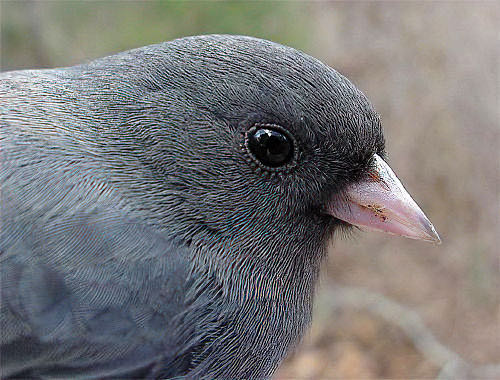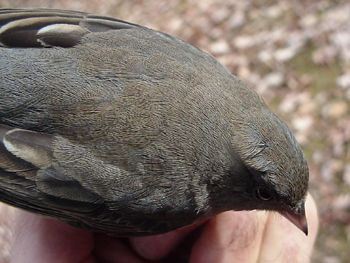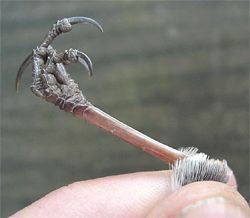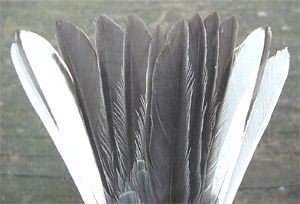|
|
|||
|
THIS WEEK at HILTON POND |
|
Hilton Pond Center is blessed with a colorful, melodious assortment of songbirds that brighten our days in spring and summer, but there are also year-round residents that settle in at our feeders and make the long winter seem a little shorter. Our Blue Jays are really bright blue, and a green cedar tree outside the farmhouse window seems even greener when adorned by the brilliant red of our local Northern Cardinals--including an eight-year old Methuselah banded in 1995 and re-trapped this week.  Then there are migrants from the north that wing their way southward, albeit in fewer numbers than in years past--perhaps because of global warming and/or a massive increase in sunflower seed feeders on the other side of the Mason-Dixon Line. In 2002, American Goldfinches and House Finches are here in respectable numbers, and this January we finally began getting Purple Finches. We even spotted our first Pine Siskin since February 2000. All these northern migrants are associated with winter in the Carolina Piedmont, but only one--the Dark-eyed Junco (above)--is known as the "Snowbird." You don't have to have frozen precipitation in the South to get juncos, of course, otherwise we'd only see them once or twice a year. These elegant little ground feeders show up at Hilton Pond Center every winter, even when there isn't a white blanket of snow.  The Dark-eyed Juncos of the eastern U.S. used to be called "Slate-colored Juncos"--which aptly described the rich gray-black color of their bibs and dorsal parts. There are juncos in other parts of the U.S. that look different, including the White-winged Junco of the Black Hills, the Gray-headed Junco of the southern Rockies, the black-headed and pink-sided Oregon Junco of the Far West, and the geographically restricted Mexican Junco that resembles a Gray-headed Junco but has yellow eyes. After years of field work, ornithologists finally discovered that all the birds with dark irises commonly interbred where their populations overlapped, which in biological circles means they couldn't be separate species. To cloud the issue a little further, we should mention that in Dark-eyed Juncos, there is still enough distinctive geographical variation to cause taxonomists to subdivide J. hyemalis into 12 different SUBspecies, all of which supposedly would interbreed if their populations ever came in contact in spring and summer. By looking carefully at birds at our feeding stations, it's pretty easy to see that here at Hilton Pond Center we actually have at least two junco subspecies scratching away at white millet and cracked corn we scatter on the ground. One of our junco flocks is composed of birds (top two photos) that are very dark, slaty-gray, and noticeably larger and longer-tailed than others that are paler and noticeably washed with brown (above right). The various Dark-eyed Juncos have some other characteristics in common besides eye color. All have pinkish to horn-colored bills and legs (above left), and their white outer tail feathers (below right) flash distinctively as they fly off into the bush. Although they all usually give chip notes when handled during the banding process, their song is a musical trill almost never heard on the wintering grounds. Occasionally an easily identifiable member of the old Oregon, Gray-headed, or White-winged Junco groups will wander into the Carolinas and generate excitement, but technically these are all Dark-eyed Juncos, so your Life List shrunk a little when they were lumped into one species. As we move ever so slowly toward that nearly unattainable total of 800, we're pleased to have tallied 164 species just at Hilton Pond Center, and we're content to enjoy the local snowbirds outside the window--with or without any snow. If you enjoy "This Week at Hilton Pond," please help Support Hilton Pond Center for Piedmont Natural History. It's painless, and YOU can make a difference! You may wish to consult our Index of all nature topics covered since February 2000. |

 So all those were lumped together as Dark- eyed Juncos (Junco hyemalis), and the Mexican bird (J. phaeonotus) remained as a discrete species now called Yellow- eyed Junco. All this name-changing didn't make a whit of difference to the snowbirds, but it put the birding world in a tizzy when folks had to give up time honored common names for their local juncos. Old field guides still have the old names, of course, but to show that you're onthithologically hip, you should use the current terminology.
So all those were lumped together as Dark- eyed Juncos (Junco hyemalis), and the Mexican bird (J. phaeonotus) remained as a discrete species now called Yellow- eyed Junco. All this name-changing didn't make a whit of difference to the snowbirds, but it put the birding world in a tizzy when folks had to give up time honored common names for their local juncos. Old field guides still have the old names, of course, but to show that you're onthithologically hip, you should use the current terminology. Carolinas observers often assume the big, dark birds are males and the rest are females, but this can be incorrect. In reality, the small, pale birds are likely Junco hyemalis hyemalis, the subspecies that breeds in Canada and the northeastern U.S., while the bigger birds are J. h. carolinensis, which nest in the Appalachian Mountains from West Virginia to as far south as north Georgia. Who woulda thunk that some of the snowbirds that visit feeders in the Carolina Piedmont and Low Country actually could have been home-grown on nearby Roan Mountain NC or Sassafras Mountain SC?
Carolinas observers often assume the big, dark birds are males and the rest are females, but this can be incorrect. In reality, the small, pale birds are likely Junco hyemalis hyemalis, the subspecies that breeds in Canada and the northeastern U.S., while the bigger birds are J. h. carolinensis, which nest in the Appalachian Mountains from West Virginia to as far south as north Georgia. Who woulda thunk that some of the snowbirds that visit feeders in the Carolina Piedmont and Low Country actually could have been home-grown on nearby Roan Mountain NC or Sassafras Mountain SC? This was terribly disconcerting to hard-core birders with Type-A personalities, but now those folks will just have to work a little harder to check off 800 different birds in North America--or wait until field research provides evidence for splitting some other bird into two species.
This was terribly disconcerting to hard-core birders with Type-A personalities, but now those folks will just have to work a little harder to check off 800 different birds in North America--or wait until field research provides evidence for splitting some other bird into two species.


